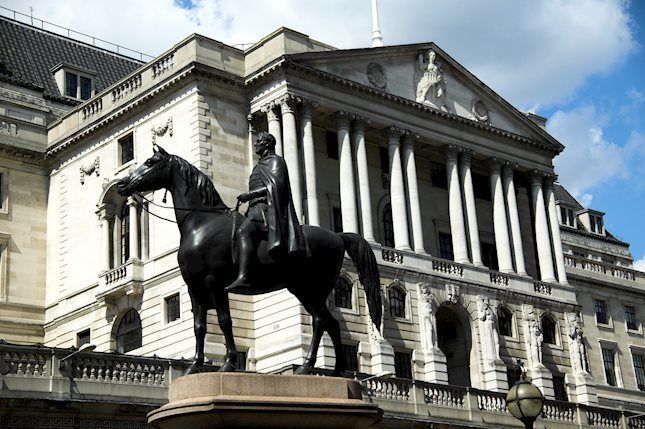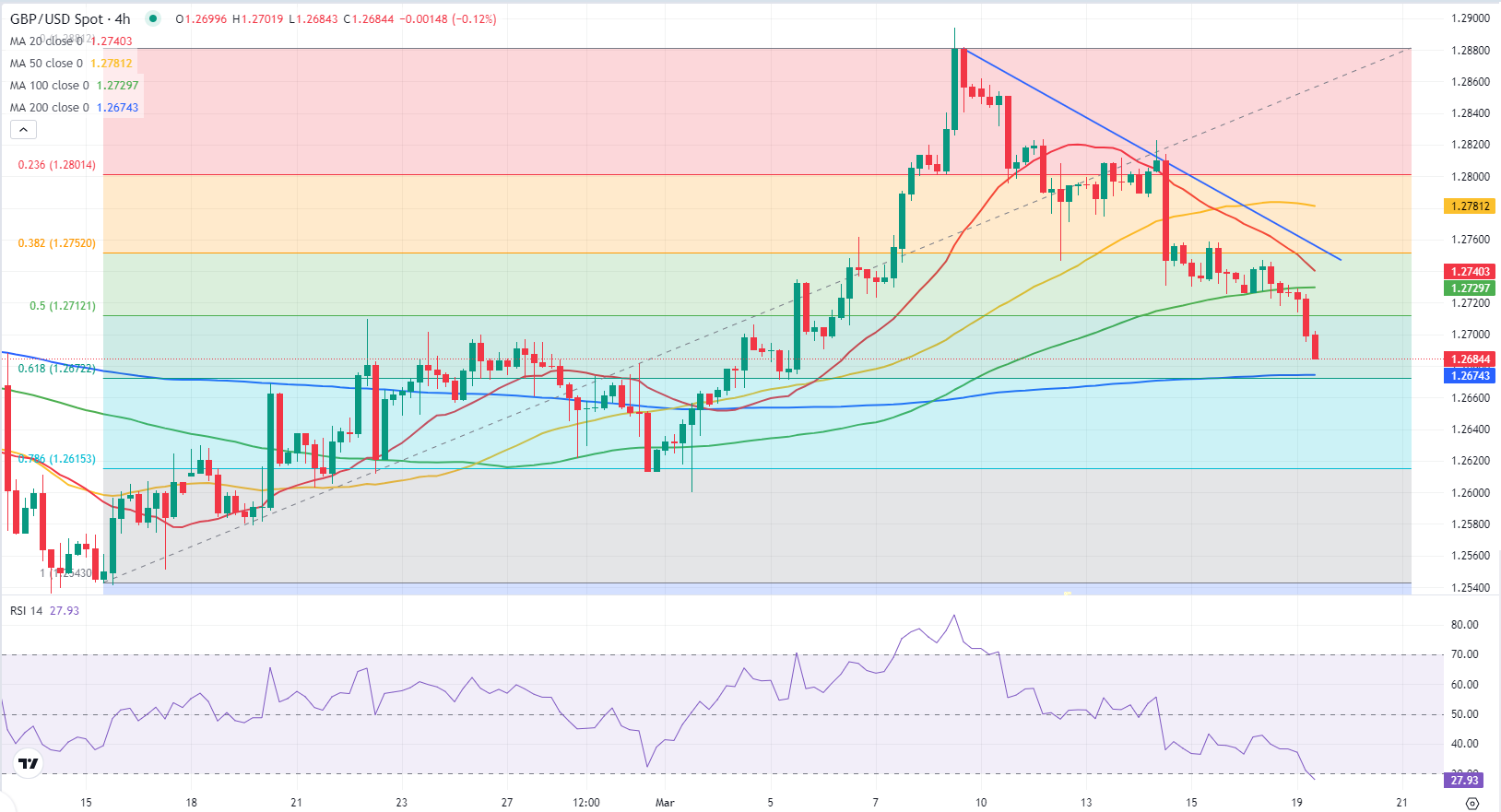- GBP/USD declined below 1.2700 for the first time in nearly two weeks.
- 1.2670 aligns as next technical support for the pair.
- Pound Sterling is close to turning to technically oversold against the USD.
Following Monday's indecisive action, GBP/USD lost its traction and dropped to its lowest level in nearly two weeks below 1.2700. The near-term technical outlook suggests that the pair is about to turn oversold.
The broad-based US Dollar (USD) strength continues to weigh on the pair ahead of the Federal Reserve (Fed) and the Bank of England (BoE) policy meetings. The benchmark 10-year US Treasury bond yield holds above 4.3% after rising over 5% in the previous week and supports the USD.
Meanwhile, US stock index futures turned negative on the day after rising marginally during the Asian trading hours. In case safe-haven flows start to dominate the financial markets after Wall Street's opening bell, the USD could preserve its strength and force GBP/USD to stay on the back foot. In the absence of high-tier data releases from the US, investors could continue to react to changes in risk perception in the near term.
Ahead of the Fed and the BoE policy decisions, the UK's Office for National Statistics will release Consumer Price Index (CPI) data for February early Wednesday. On a yearly basis, the annual CPI inflation in the UK is forecast to soften to 3.6% from 4% in January.
GBP/USD Technical Analysis
The Relative Strength Index (RSI) indicator on the 4-hour chart stays slightly below 30, suggesting that the pair is close to turning technically oversold. The last two times that the RSI dipped to the 30 area on the same chart in early and late February, GBP/USD staged a technical correction.
In case GBP/USD starts correcting higher, the Fibonacci 50% retracement level of the latest uptrend could act as first resistance near 1.2710 before the 100-period Simple Moving Average (SMA) at 1.2730 and 1.2750 (Fibonacci 38.2% retracement, descending trend line).
On the downside, 1.2670 (200-period SMA) aligns as key support before 1.2620 (Fibonacci 61.8% retracement) and 1.2600 (static level).
Pound Sterling FAQs
The Pound Sterling (GBP) is the oldest currency in the world (886 AD) and the official currency of the United Kingdom. It is the fourth most traded unit for foreign exchange (FX) in the world, accounting for 12% of all transactions, averaging $630 billion a day, according to 2022 data. Its key trading pairs are GBP/USD, aka ‘Cable’, which accounts for 11% of FX, GBP/JPY, or the ‘Dragon’ as it is known by traders (3%), and EUR/GBP (2%). The Pound Sterling is issued by the Bank of England (BoE).
The single most important factor influencing the value of the Pound Sterling is monetary policy decided by the Bank of England. The BoE bases its decisions on whether it has achieved its primary goal of “price stability” – a steady inflation rate of around 2%. Its primary tool for achieving this is the adjustment of interest rates. When inflation is too high, the BoE will try to rein it in by raising interest rates, making it more expensive for people and businesses to access credit. This is generally positive for GBP, as higher interest rates make the UK a more attractive place for global investors to park their money. When inflation falls too low it is a sign economic growth is slowing. In this scenario, the BoE will consider lowering interest rates to cheapen credit so businesses will borrow more to invest in growth-generating projects.
Data releases gauge the health of the economy and can impact the value of the Pound Sterling. Indicators such as GDP, Manufacturing and Services PMIs, and employment can all influence the direction of the GBP. A strong economy is good for Sterling. Not only does it attract more foreign investment but it may encourage the BoE to put up interest rates, which will directly strengthen GBP. Otherwise, if economic data is weak, the Pound Sterling is likely to fall.
Another significant data release for the Pound Sterling is the Trade Balance. This indicator measures the difference between what a country earns from its exports and what it spends on imports over a given period. If a country produces highly sought-after exports, its currency will benefit purely from the extra demand created from foreign buyers seeking to purchase these goods. Therefore, a positive net Trade Balance strengthens a currency and vice versa for a negative balance.
Information on these pages contains forward-looking statements that involve risks and uncertainties. Markets and instruments profiled on this page are for informational purposes only and should not in any way come across as a recommendation to buy or sell in these assets. You should do your own thorough research before making any investment decisions. FXStreet does not in any way guarantee that this information is free from mistakes, errors, or material misstatements. It also does not guarantee that this information is of a timely nature. Investing in Open Markets involves a great deal of risk, including the loss of all or a portion of your investment, as well as emotional distress. All risks, losses and costs associated with investing, including total loss of principal, are your responsibility. The views and opinions expressed in this article are those of the authors and do not necessarily reflect the official policy or position of FXStreet nor its advertisers. The author will not be held responsible for information that is found at the end of links posted on this page.
If not otherwise explicitly mentioned in the body of the article, at the time of writing, the author has no position in any stock mentioned in this article and no business relationship with any company mentioned. The author has not received compensation for writing this article, other than from FXStreet.
FXStreet and the author do not provide personalized recommendations. The author makes no representations as to the accuracy, completeness, or suitability of this information. FXStreet and the author will not be liable for any errors, omissions or any losses, injuries or damages arising from this information and its display or use. Errors and omissions excepted.
The author and FXStreet are not registered investment advisors and nothing in this article is intended to be investment advice.
Recommended Content
Editors’ Picks

EUR/USD under pressure below 1.0550 on persistent USD strength
EUR/USD trades deep in the red below 1.0550 on Wednesday. The US Dollar benefits from rising US Treasury bond yields and the cautious market mood, forcing the pair to stay on the back foot. Several Federal Reserve policymakers will be delivering speeches later in the day.

GBP/USD declines toward 1.2650, erases post-CPI gains
GBP/USD loses its traction and retreats toward 1.2650 on Wednesday. Although the stronger-than-expected inflation data from the UK helped Pound Sterling gather strength earlier in the day, the risk-averse market atmosphere caused the pair to reverse its direction.

Gold now retargets the $2,700 region
Following a pullback during the European trading hours, Gold regains its traction and climbs toward $2,650. Escalating geopolitical tensions help XAU/USD stretch higher, while rising US Treasury bond yields limit the pair's upside.

Why is Bitcoin performing better than Ethereum? ETH lags as BTC smashes new all-time high records
Bitcoin has outperformed Ethereum in the past two years, setting new highs while the top altcoin struggles to catch up with speed. Several experts exclusively revealed to FXStreet that Ethereum needs global recognition, a stronger narrative and increased on-chain activity for the tide to shift in its favor.

Sticky UK services inflation to keep BoE cutting gradually
Services inflation is set to bounce around 5% into the winter, while headline CPI could get close to 3% in January. That reduces the chance of a rate cut in December, but in the spring, we think there is still a good chance the Bank of England will accelerate its easing cycle.

Best Forex Brokers with Low Spreads
VERIFIED Low spreads are crucial for reducing trading costs. Explore top Forex brokers offering competitive spreads and high leverage. Compare options for EUR/USD, GBP/USD, USD/JPY, and Gold.
